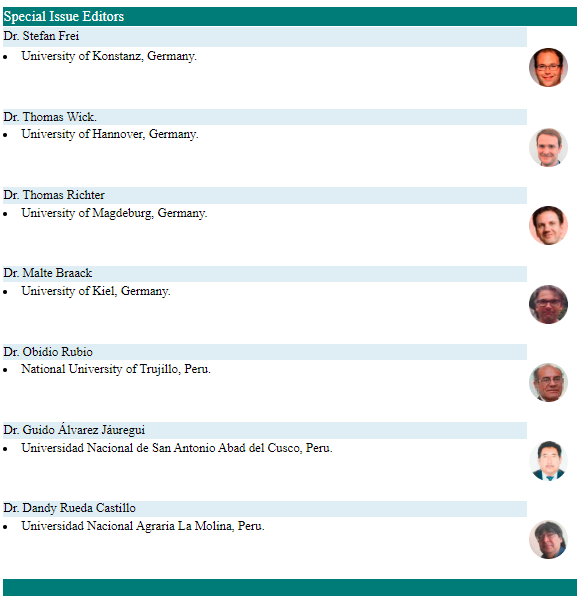El teorema de Fatou; su contribución al análisis armónicos
DOI:
https://doi.org/10.17268/sel.mat.2025.01.15Palabras clave:
Fatou, medida armónica, Lipschitz, Hp, BMO, integral área, función N(u), Clase ApResumen
El objetivo de este artículo es ver como el teorema de Fatou, dado a inicios del siglo XX, motivó nuevos desarrollos en el análisis armónico y en las ecuaciones en derivadas parciales en la segunda mitad de tal siglo. En este escrito damos un breve recorrido por algunas de las contribuciones dadas por distinguidos analistas y de esta manera nuestro interés es dar a conocer en el Perú tales progresos y así contribuir con el desarrollo de esta bella rama del análisis matemático, que creemos es casi desconocida en nuestro país. En particular hemos puesto cierta atención al trabajo de Jerison - Kenig [1], por contener tal trabajo un panorama que ayuda a cumplir con nuestro objetivo.
Citas
Jerison D, Kenig C. Boundary behavior of harmonic functions in non - tangentially accessible domains. Advances in Math. 1982.
Fatou P. Séries trigonométriques et séries de Taylor. Acta Mathematica. 1906.
Helms LL. Introduction to potential theory. Wiley - Interscience. 1969.
Calderón AP. On the behavior of harmonic functions near the boundary. Trans Amer Math Soc. 1950.
Calderón AP. On a theorem of Marcinkiewicz and Zygmund. Trans Amer Math Soc. 1950.
Stein EM. Singular integral and differentiability properties of functions. Princeton, New Jersey. Princ. Univ. Press.1970.
Carleson L. On the existence of boundary values for harmonic functions in several variables. Ark Math. 1962.
Hunt R, Wheeden R. On the boundary values of harmonic functions. Trans Amer Math Soc.1968.
Jerison D, Kenig C. Boundary value problems on Lipschitz domains. MAA Studies in Mat. 1982.
Stein EM, Weiss G. Introduction to Fourier analysis on Euclidean spaces. Princ Univ Press.1971.
Dahlberg B. Estimates of harmonic measure. Arch. for Rat. Mech. and Anal. 65. 1977.
Dahlberg B. On the Poisson integral for Lipschitz and C1 domains. Studia Math. 66. 1977.
Dahlberg B.Weighted norm inequalities for the Lusin area integral and the non - tangential maximal functions for functions harmonic in a Lipschitz domain. Studia . Math. 1979.
Stein EM. On the theory of harmonic functions of several variables. II. Behavior near the boundary. Acta Math. 106. 1961.
Gundy RF, Wheeden RL. Weighted integral inequalities for the nontangential maximal function, Lusin area integral, and Walsh - Paley series. Studia Math. T. XLIX. 1974.
Fefferman Ch, Stein EM. Hp - spaces of several variables. Acta Math. 129. 1972.
Burkholder D, Gundy R. Distribution function inequalities for the area integral. Studia Math. 44. 1972.
Fabes E, Jodeit M, Riviere N. Potential techniques for boundary value problems on C1 domains. Acta Math. 141.1978.
Jerison D, Kenig C. The Neumann problem on Lipschitz domains. Bul. Amer. Soc .Vol. 4 . 1981.
Calderón AP. Cauchy integral on Lipschitz curves and related operators. Proc. Nati. Acad. Sci. USA. Vol. 74. No 4. 1977.
Coifman R. A real variable characterization of Hp. Studia Math. 51. 1974.
John F, Nirenberg L. On functions of bounded mean oscillation . Comm. Pure and Appl. Math. Vol 14. 1961.
Coifman R, Weiss G. Extensions of Hardy spaces and their use in analysis. Bull. A.M.S. Vol. 83. No 4. 1977.
Calderón AP. Commutators of singular integral operators. Proc. Nat. Acad. Sci. U.S.A. 1965.
Segovia C. On the area function of Lusin. Studia Mathematica. T. XXIII. 1969.
Chanillo S, et al. Richard L. Wheeden - In Memoriam 1940 - 2020. Notices Amer. Math. Soc. Vol. 69. No 2. 2020.
Kenig CE. Recent progress on boundary - value problems on Lipschitz domains. Proc. of Sym. in Pure Math. Vol. 43. 1985.
Jerison D, Kenig C. An identity with applications to harmonic measure. Bull. Amer. Math. Soc. (N. S.)2. 1980.
Jerison D, Kenig C. The Dirichlet problem in non - smooth domains. Annals of Math, 113. 1981.
Zygmund A. Trigonometrical series. Dover Public. (1935 - 1955). Trigonometric series. 2nd Ed. Cambridge Univ. Press. London. 1968.
Stein EM. Harmonic analysis: Real - variable methods, orthogonality, and oscillatory integrals. Princeton, New Jersey. Princ. Univ. Press. 1993.
Torchinsky A. Real - variable methods in harmonic analysis. Academic Press. Inc. New York. 1986.
Cuerva JG, de Francia RJ. Weighted norm inequalities and related topics. North - Holland. New York. 1985.
Jaffard S, Meyer Y, Ryan R. Wavelets. Tools for Science and Technology. Siam. Philadelphia. 2001.
Capogna L, Kenig C, Lanzani L. Harmonic measure. Geometric and analytic points of view. Amer. Math. Soc. Univ. Lect. Series. Vol 35. 2005.
Ortiz A. Tópicos sobre análisis armónico. Notas de Matemática 4. Dpto. de Matemática. Univ. Nac. de Trujillo. Perú. 1988.
Ortiz A. Alberto P. Calderón. Teoría del potencial e integrales singulares. Una perspectiva histórica. Selecciones Matemáticas. Vol. 04(02). UNT: 2017.
Kenig CE. Harmonic analysis techniques for second order elliptic boundary value problems. CBMS. No 83. AMS. 1994.
Macías R, Segovia C. Lipschitz functions on spaces of homogeneous type. Advances in Mathematics 33. 1979.
Ortiz A. Espacios de Hardy Hp y BMO: un breve clásico panorama. UNT. Selecciones Matemática. Vol- 9(2).2022.
Descargas
Publicado
Cómo citar
Número
Sección
Licencia

Esta obra está bajo una licencia internacional Creative Commons Atribución 4.0.
Los autores/as que publiquen en esta revista aceptan las siguientes condiciones:
- Los autores/as conservan los derechos de autor y ceden a la revista el derecho de la primera publicación, con el trabajo registrado con la licencia de atribución de Creative CommonsAtribución 4.0 Internacional (CC BY 4.0) , que permite a terceros utilizar lo publicado siempre que mencionen la autoría del trabajo y a la primera publicación en esta revista.
- Los autores/as pueden realizar otros acuerdos contractuales independientes y adicionales para la distribución no exclusiva de la versión del artículo publicado en esta revista (p. ej., incluirlo en un repositorio institucional o publicarlo en un libro) siempre que indiquen claramente que el trabajo se publicó por primera vez en esta revista.
- Se permite y recomienda a los autores/as a publicar su trabajo en Internet (por ejemplo en páginas institucionales o personales) antes y durante el proceso de revisión y publicación, ya que puede conducir a intercambios productivos y a una mayor y más rápida difusión del trabajo publicado(Consultar: efecto del acceso abierto).













